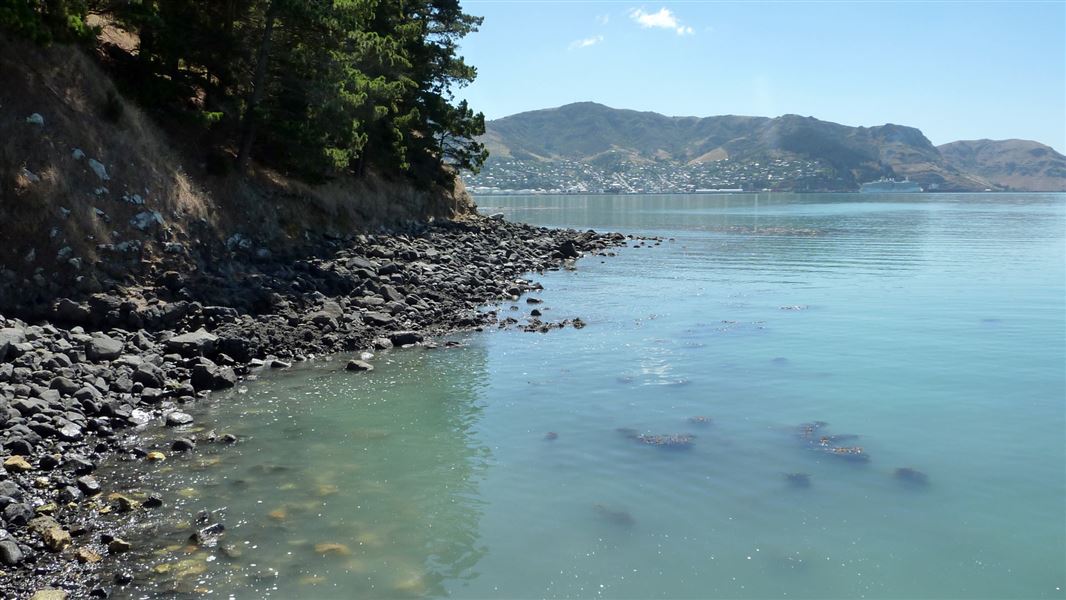Easy grades make the walks on this island suitable for small children and family groups.
Image gallery
Video
Brochures
Discover Quail Island (PDF, 1,006K)
Ōtamahua/Quail Island lies within Whakaraupō/Lyttelton Harbour, close to Christchurch City.
There is a regular ferry service from Lyttelton Wharf. Ensure you know when the last ferry leaves Quail Island to get back to Lyttelton. Black Cat Cruises schedule and fees.
Alternatively, you can make your own way to the Island by canoe, kayak or private boat.
Whakamaru (Swimmers) beach, Skiers Beach or Walkers Beach are the recommended places to land/launch canoes or kayaks. There is also plenty of room to pull up a boat. Care is required as these areas will be shallow or mud flats at low tide. The majority of the island’s coast is unsuitable for landings. Check the weather forecast before you leave for the island.
The wharf is not suitable for overnight mooring.
- Toilets are located at Ōtamahua Hut, Whakamaru Beach (Swimmers Beach) and Skiers Beach.
- Boil water before use.
- Most track surfaces on the Island are evenly graded or grassed, but sturdy footwear is recommended.
- The Island contains a number of unmarked tracks used by the Ōtamahua / Quail Island Ecological Restoration Trust for planting access - stay on sign-marked tracks to avoid stepping on new plants and for your own personal safety.
- Carry adequate clothing and be prepared for sudden changes in the weather – parts of the Island are exposed.
- There are steep unfenced cliffs. Small children should be kept under close supervision at all times.
- There is a danger of windfall or treefall in high or gusty wind conditions.
- Mobile reception is available on the island.
- The wharf is not suitable for overnight mooring.
Ōtamahua/Quail Island is at times subject to extreme fire danger
If fire breaks out on the Island:
- head to the nearest beach or coastal area, if it is safe to do so.
- if you have a mobile, dial 111 for fire.
Look after the island
- No open fires
- No animals, including dogs
- No unauthorised vehicles, including mountain bikes
- No firearms
- No drones
- All wildlife, plants, and natural and historic features are protected. Be respectful and keep to the tracks.
- Take home all your rubbish.
- Bait stations and predator traps are in use at all time. Read the warning signs on the wharf and around the Island.
Protect our wildlife
- Check - your gear for pests, eg rodents, insects, skinks.
- Clean - footwear and gear, removing soil and seeds.
Geology
The island is 81 ha in area, with a high point of 86 metres. It lies in the flooded crater of an extinct volcano - Te Whakaraupō/Lyttelton Harbour.
There were two rock quarries on the island. The columnar basaltic rock was used as ballast by early sailing ships returning home without cargo. Rhyolite stone was also quarried from above Walkers Beach by ‘hard labour gangs’ of prisoners brought over from the mainland. The stone was used to build walls and terraces along the foreshore which can be still seen today.
Wildlife
Birds such as black-backed/karoro and red-billed gull/tarāpunga, white-flippered penguins/kororā, terns, shags and oystercatchers are often seen from the observation point. Fantails/pīwakawaka and grey warblers/ iroriro are present on the island.
Banks Peninsula tree weta have recently been transferred to the island - you may see custom-built weta homes attached to the trunks of manuka trees.
On warm summer days you’re likely to spot resident lizards like geckos and skinks.
The Ōtamahua/Quail Island Ecological Restoration Trust and DOC are working to establish native vegetation and re-introduce native wildlife. A maintained network of traps protects the island from introduced predators, with the exception of mice. The island has been free of possums, rabbits, cats, hedgehogs, mustelids and rats since 2006.
Ōtamahua/Quail Island is a place rich in history and culture and boasts a number of local, and national historic sites. See history of Ōtamahua/Quail Island.
Check you are pest-free
Check, clean, and seal your gear to ensure you don't bring pests, soil, and seeds.
Arthur's Pass National Park Visitor Centre
| Phone: | +64 3 318 9211 |
| Email: | arthurspassvc@doc.govt.nz |
| Address: | 104 West Coast Road Arthur's Pass 7654 |
| Hours: | Visitor centre hours and services |
